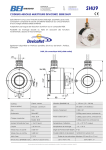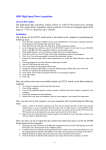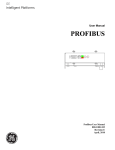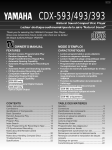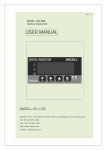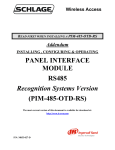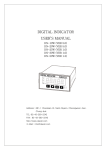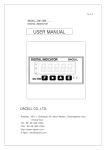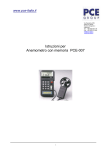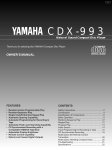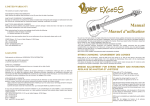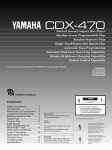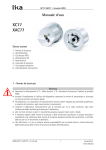Download MANUEL D`UTILISATION POUR CODEUR Profibus DP
Transcript
IDEACOD hohner AUTOMATION S.A. B.P. 2 F 67038 STRASBOURG CEDEX Tél. Fax : (33) 388 789 378 : (33) 388 789 389 MANUEL D'UTILISATION POUR CODEUR Profibus DP PROCESS FIELD BUS Certifié Dernière mise à jour: 17/12/98 Manuel d'utilisation Profibus DP Rev. 1.1 Ideacod – hohner AUTOMATION S.A. Table des matières 1. Introduction .................................................................................................................... 3 1.1 Le codeur absolu ........................................................................................................ 3 1.2 Profil ........................................................................................................................... 4 1.3 Définitions................................................................................................................... 4 2. Le reseau Profibus-DP ................................................................................................... 5 2.1 Les Câbles sous Profibus ........................................................................................... 5 2.2 structure du Segment ................................................................................................. 6 2.3 Utilisation des répéteurs ............................................................................................. 6 3. Classification des codeurs.............................................................................................. 7 3.1 Codeurs Classe 1 ....................................................................................................... 7 3.2 Class 2 Encoder ......................................................................................................... 7 4. Programmable Encoder Parameters .............................................................................. 9 4.1 Code Sequence.......................................................................................................... 9 4.2 Class 2 Functionality................................................................................................. 10 4.3 Commissioning Diagnostics (optional) ...................................................................... 10 4.4 Scaling Function ....................................................................................................... 10 4.5 Measuring Units per Revolution ................................................................................ 11 4.6 Total Measuring Range in Measuring Units .............................................................. 11 4.7 Preset Value ............................................................................................................. 11 5. Diagnostic Information ................................................................................................. 13 5.1 Extended Diagnostic Header .................................................................................... 13 5.2 Alarms ...................................................................................................................... 14 5.3 Operating Status....................................................................................................... 14 5.4 Encoder Type ........................................................................................................... 14 5.5 Single-Turn Resolution ............................................................................................. 15 5.6 Number of Distinguishable Revolutions .................................................................... 15 5.7 Additional Alarms...................................................................................................... 15 5.8 Supported Alarms..................................................................................................... 15 5.9 Warnings .................................................................................................................. 16 5.10 Supported Warnings ............................................................................................. 16 5.11 Profile Version....................................................................................................... 17 5.12 Encoder Software Version..................................................................................... 17 5.13 Operating time ...................................................................................................... 17 5.14 Offset value........................................................................................................... 18 5.15 Offset value of the Encoder manufacturer............................................................. 18 5.16 Scaling parameter settings.................................................................................... 19 5.17 Encoder serial number .......................................................................................... 19 6. Annexe......................................................................................................................... 20 6.1 Installation ................................................................................................................ 20 6.1.1 Connecting the Connection cap......................................................................... 20 6.1.2 Configuring the device Address ......................................................................... 20 6.1.3 Dip switches ...................................................................................................... 20 6.1.4 Switch signification ............................................................................................ 21 6.1.5 Set_Slave_Address ........................................................................................... 21 6.1.6 Line termination ................................................................................................. 21 6.1.7 Type File............................................................................................................ 21 6.1.8 Configuration of the BUS ................................................................................... 23 6.2 TECHNICAL DATA................................................................................................... 28 6.2.1 Electrical Data ................................................................................................... 28 6.2.2 Mechanical data ................................................................................................ 28 6.2.3 Shielding (From WWW.PROFIBUS.COM) ........................................................ 28 1. Page 2/2 Manuel d'utilisation Profibus DP Rev. 1.1 Ideacod – hohner AUTOMATION S.A. INTRODUCTION 1.1 Le codeur absolu Les codeurs absolus rotatifs fournissent une valeur unique pour chaque position possible. Toutes ces valeurs proviennent d'un disque codé, un rayon lumineux infra-rouge traverse le disque et est reçu par un opto-asic. Les signaux résultants sont amplifiés et transférés à l'interface. Le codeur absolu a comme résolution maximum 8192 points/tour (13 bits). La version multitours peut compter jusqu'à 65536 tours (16 bits). Par conséquent La résolution totale du codeur est de 29 bits= 229 = 536.870.912 points. Le codeur monotour en standard a une résolution de 13 bits, le multitours 29 bits. Le codeur absolu respecte toutes les spécifications relatives à PROFIBUS DP, DIN 19245 première et deuxième partie. L'interface Profibus DP du codeur garanti un taux de transfert jusqu'à 12 Mbaud. Le logiciel développé supporte toutes les fonctions du profil Profibus DP Classe 1 et Classe 2. Les données du codeur sont transmises en code binaire. Les paramètres suivant du codeur absolu peuvent être directement reprogrammées au travers du bus Profibus DP : • • • • Sens de croissance du code (Complément) Nombre de points par tour Nombre de points total Valeur de Présélection (Prese)t Pour réduire de manière significative le temps de configuration et d'installation, un fichier GSD de définition du codeur est fourni pour être utilisé avec la version Windows de Com Profibus. Ce logiciel est supporté par Siemens et est destiné a la configuration des modules IM308C de la famille d'automate Simatic S5 ainsi que pour une grande variété de modules du Simatic S7 Le succès au test de conformité et d'interopérabilité du laboratoire Siemens garanti une communication sans erreur entre le codeur et tous les systèmes Profibus DP. Page 3/3 Manuel d'utilisation Profibus DP Rev. 1.1 Ideacod – hohner AUTOMATION S.A. 1.2 Profil Ce codeur respecte le profil des codeurs Profibus DP, version 1.1 de mai 1997. 1.3 Définitions Résistance de Terminaison Résistance de terminaison pour l'adaptation d'impédance des paires; les résistances de terminaison sont nécessaires à chaque extrémité de câble et de segment.. Baudrate Vitesse de transmission; donnée en nombre de bits par seconde transmis (Baudrate = Bitrate). Busdevice Module qui envoie, reçoit ou répète des données sur le Bus. Diagnostique Détection, localisation, classification, affichage, contrôles d'erreurs, malfonctions et messages. FREEZE est une commande du maître pour l'esclave. Elle permet de figer l'état des entrées à leur valeur actuelle. Les données d'entrée seront rafraîchies lorsque la commande UNFREEZE sera envoyée par le maître. Fichier GSD Fichier de caractéristiques du codeur. Fichier, dans lequel les informations relatives au codeur sont stockées, a destination du maître. DP Périphérie décentralisée DDLM Direct Data Link Mapper Interface entre les fonctions Profibus DP et le programme du codeur. PROFIBUS PROcess Fleldbus, norme de bus de terrain européenne, qui est décrite dans la norme PROFIBUS (EN 50170). Elle définit les fonctionnalités, les spécifications électriques et mécaniques du système de bus sériel. Les abréviations suivantes seront utilisées dans ce manuel: H Horaire. Croissance du code pour une rotation horaire de l'axe (vu du coté de l'axe codeur) AH Anti-Horaire. Croissance du code pour une rotation antihoraire de l'axe (vu du coté de l'axe codeur) PO Valeur de la position PR Valeur de Présélection Page 4/4 Manuel d'utilisation Profibus DP Rev. 1.1 Ideacod – hohner AUTOMATION S.A. 2. LE RESEAU PROFIBUS-DP L'interface des codeurs absolus rotatifs est basée sur la norme PROFIBUS-DP (DIN 19245, Part 1 et 3). Pour utiliser le codeur à interface Profibus DP comme esclave, un module maître Profibus-DP tel qu'un automate est nécessaire. Ci-dessous est schématisé le principe de connexion PROFIBUS-DP. 2.1 Les Câbles sous Profibus Pour les réseaux PROFIBUS, restrictions suivantes: utiliser un câble adapté en accord avec les Pour atteindre les longueurs maximum, il est nécessaire d'utiliser des répéteurs, ils régénèrent l'amplitude et la chronologie des signaux. Il est possible de connecter jusqu'à 9 répéteurs. Page 5/5 Manuel d'utilisation Profibus DP Rev. 1.1 Ideacod – hohner AUTOMATION S.A. 2.2 structure du Segment Twisted, shielded 2-wire line Repeater Bus Terminal ... Bus Connector 1200 m (RS 485) max., 32 Stations max. 2.3 Utilisation des répéteurs Connect segments* Remote Repeater ... ... Interface for SINEC L2FO Networks .. . Branch segments Max. Number Repeater Cascading: 9 Page 6/6 Link Segment (Segment without stations) Manuel d'utilisation Profibus DP Rev. 1.1 Ideacod – hohner AUTOMATION S.A. 3. CLASSIFICATION DES CODEURS Les codeurs absolus en Profibus DP transmettent la valeur de la position codée en binaire. Il existe deux classes différentes de codeurs, les non programmables (Classe 1) et les programmables (Classe 2). Quatre configurations sont possibles d'où la possibilité de répondre à une grande variété de configurations. 3.1 Codeurs Classe 1 The absolute encoders of Class 1 are unprogrammable. Depending on the resolution two configurations can be chosen: Conf. No. 1 2 Type Class 1 1 Configuration Length Byte 1 D0 1 D1 Input-Word No. 1 2 Output-Word No. 0 0 Description 16 Bit PO 32 Bit PO If the resolution of the encoder is less than 16 Bit, configuration 1 can be chosen. The position value (PO) is transmitted to the PROFIBUS-Master according to the hardware side of the resolution of encoder. 3.2 Class 2 Encoder The absolute encoders of Class 2 are programmable. Depending on the resolution two configurations can be chosen: Conf. No. 3 Type Class 2 Configuration Length Byte 1 F0 Input-Word No. 1 Output-Word No. 1 4 2 1 F1 2 2 Description 16 Bit PO 16 Bit PR 32 Bit PO 32 Bit PR If the resolution of the encoder less than 16 Bit, configuration No.3 can be chosen. Class 2 encoders offer extensive programming possibilities, e.g. preset function and programmable resolution. Page 7/7 Manuel d'utilisation Profibus DP Rev. 1.1 Ideacod – hohner AUTOMATION S.A. The PO is transmitted in the DDLM_Data_Exchange Modus according to following telegram: Configurations No.: 1 and 3 Octet Bit Data 1 2 15 - 8 7-0 15 - 8 7 0 2 2 2 -2 Data_Exchange - 16 Bits Configurations No. : 2 and 4 Octet Bit Data 1 31 - 24 31 24 2 -2 2 3 23 - 16 15 - 8 23 16 15 8 2 -2 2 -2 Data_Exchange - 32 Bits Page 8/8 4 7-0 7 0 2 -2 Manuel d'utilisation Profibus DP Rev. 1.1 Ideacod – hohner AUTOMATION S.A. 4. PROGRAMMABLE ENCODER PARAMETERS In the following the encoder parameters are described, which can be programmed according to the chosen configuration. The Class 2 parameters use the DDLM_Set_Prm function. Programmable parameters are shown in the table below: Parameter Code Sequence Class 2 functionality Commissioning diag. control Scaling function control Measuring units per rev. Total measuring range Reserved for further use Reserved for manufacturer Data type Parameter octet number Bit 9 Bit 9 Bit 9 Bit 9 unsigned 32 10 - 13 unsigned 32 14 - 17 18 - 25 26... Device class 1 2 optional 2 2 2 2 optional Overview Operating Parameter (Octet 9): Bit 0 1 2 3 4 5 6 7 Parameter Code Sequence Class 2 functionality Commissioning diagnostics Scaling function control Reserved Reserved Reserved Reserved 4.1 Code Sequence The code sequence defines whether increasing position values are output when the encoder shaft rotates clockwise CW or counterclockwise CCW (as seen on shaft). The code sequence bit is set with the code sequence bit 0 in the operating parameters Octet 9. Bit 0 0 1 Code sequence CW CCW Page 9/9 Manuel d'utilisation Profibus DP Rev. 1.1 Ideacod – hohner AUTOMATION S.A. 4.2 Class 2 Functionality This bit enables/disables the device class 2 functionality. The default setting is disabled (0), which means that a DP-Master must set this bit to be able to use the class 2 functions. When the class 2 functionality is disabled, the encoder performs exactly like a class 1 encoder. To use class 2 functionality, set bit 1 in Octet 9.*0 Bit 1 0 1 Class 2 Functionality disabled enabled 4.3 Commissioning Diagnostics (optional) With the commissioning diagnostic function it is possible to check the encoder components responsible for position detection at encoder standstill. In conjunction with the position alarms, this enables an extensive check of the correctness of the position values. The commissioning diagnostics are initiated by the bit 2 in octet 9. If errors are detected it will be announced by the commissioning diagnostic alarm bit in the diagnostic function (see Alarms). Bit 2 0 1 Commissioning Diagnostics disabled enabled The commission diagnostic function is optional. To find out if the encoder supports commissioning diagnostics, the « Operating Status » should be read with the diagnostic function and the commissioning diagnostic bit checked. 4.4 Scaling Function With the scaling function the encoder internal numerical value is converted in software to change the physical resolution of the encoder. The parameters « Measuring Units per Revolution » and « Total Measuring Range in Measuring Units » are the scaling parameters set by the scaling function control bit 3 in octet 9. Bit 3 0 1 Scaling Function disabled enabled Page 10/10 Manuel d'utilisation Profibus DP Rev. 1.1 Ideacod – hohner AUTOMATION S.A. 4.5 Measuring Units per Revolution The parameter « Measuring Units per revolution » is used to program the desired number of steps per revolution. Each value between 1 and 8192 can be realised. Octet Bit Data 10 11 12 13 31 - 24 23 - 16 15 - 8 7-0 31 24 23 16 15 8 7 0 2 -2 2 -2 2 -2 2 -2 Measuring Units per Revolution If a value larger than 8192 is set, the process value of the encoder will not be single stepped and values will be skipped while rotating the shaft. So, it is recommended, to keep the measuring units per revolution below 8192 measuring units. 4.6 Total Measuring Range in Measuring Units This parameter is used to program the desired number of measuring units over the total measuring range. This value must not exceed the total resolution of the encoder with 536870912 steps (29 Bit). If the encoder is used in a continuous measuring application, the parameter must be x programmed in values with powers of 2 (2 with x<= 29). Octet Bit Data 14 15 16 17 31 - 24 23 - 16 15 - 8 7-0 31 24 23 16 15 8 7 0 2 -2 2 -2 2 -2 2 -2 Total Measuring Range in Measuring Units 4.7 Preset Value The parameter « Preset Value » is the desired position value, which should be reached at a certain physical position of the axis. The position value of the encoder is set to the desired process value by the parameter Preset. The preset value must not exceed the parameter « Total Measuring Range in Measuring Units ». The preset function is used after the scaling function which means that the preset value is given in the current measuring units. The preset value is written to the encoder as output data in the Data_Exchange function. The MSB of the preset value controls the preset function in the following way: Normal operating mode: MSB = 0 (Bit 31) The encoder will make no change in preset value. Page 11/11 Manuel d'utilisation Profibus DP Rev. 1.1 Ideacod – hohner AUTOMATION S.A. Preset mode: MSB = 1 (Bit 31) With MSB=1 the encoder accepts the transferred value (Bit: 0-28) as a preset value in binary code. The encoder reads the current position value and calculates an offset value from the preset value and the read position value. The position value is shifted with the calculated offset value. When the output position value equals the preset value the preset mode is ended and the MSB can be set to zero by the master. The offset value can be read with the diagnostic function and is securely stored in case of voltage breakdown in the encoder EEPROM. Attention: The preset function should only be used at encoder standstill! Page 12/12 Manuel d'utilisation Profibus DP Rev. 1.1 Ideacod – hohner AUTOMATION S.A. 5. DIAGNOSTIC INFORMATION The encoder supports extensive diagnostic routines. A large number of different parameters can be tested via the network. Diagnostic function Data type Extended diagnostic header Alarms Operating status Encoder type Singleturn resolution Number of distinguishable revolutions Additional alarms Supported alarms Warnings Supported warnings Profile version Software version Operating time Offset value Manufacturer offset value Measuring units per revolution Total measuring range in measuring units Serial number Reserved for future use Manufacturer specific diagnostics Octet string Octet string Octet string Octet string Unsigned 32 Unsigned 16 Octet string Octet string Octet string Octet string Octet string Octet string Unsigned 32 Signed 32 Signed 32 Unsigned 32 Unsigned 32 ASCII string Diagnostic octet number 7 8 9 10 11 - 14 15 - 16 17 18 - 19 20 - 21 22 - 23 24 - 25 26 - 27 28 - 31 32 - 35 36 - 39 40 - 43 44 - 47 48 - 57 58 - 59 60 - 63 Encoder class 1 1 1 1 1 1 2 2 2 2 2 2 2 2 2 2 2 2 2 Optional 5.1 Extended Diagnostic Header The diagnostic header byte 7 specifies the length of the encoder diagnostics including the header byte. The format of the length value is hexadecimal. For the encoders with Class 1 configuration the length of the encoder specific diagnostics is 10 bytes (0A hex). Bit Data 7 6 0 0 Fixed to 00 indicate device related diagnostics 5-0 xxh Length including header Page 13/13 Manuel d'utilisation Profibus DP Rev. 1.1 Ideacod – hohner AUTOMATION S.A. 5.2 Alarms An alarm is set if malfunction in the encoder could lead to incorrect process values. Octet 8 in the diagnostic function (DDLM_Slave_Diag) shows the status of the alarms. Additional alarms for class 2 encoders are added in diagnostic octet 17. If an alarm occurs, then the Ext_Diag bit and the Stat_Diag bit in the diagnostic function is set to logical high until the alarm is cleared and the encoder is able to provide an accurate process value. Alarms are cleared when the functionality is within the specification and the process value is correct. Bit 0 1 2 3 4 Definition Position error Supply Voltage error Current too high Commissioning diagnostics Memory error =0 No No No OK No =1 Yes Yes Yes Error Yes These alarms are not supported today. 5.3 Operating Status Octet 9 in the diagnostic function gives information on encoder internal parameters. Bit 0 1 2 3 Definition Code sequence Class 2 functionality Commissioning diagnostics Scaling function =0 CW No No, not supported Disabled =1 CCW Yes Yes Enabled The commissioning diagnostics are not implemented yet. 5.4 Encoder Type The encoder type can be read in Octet 10 of the hex code. code 00 h 01 h Definition Single-Turn absolute rotary encoder Multi-Turn absolute rotary encoder Page 14/14 Manuel d'utilisation Profibus DP Rev. 1.1 Ideacod – hohner AUTOMATION S.A. 5.5 Single-Turn Resolution The diagnostic octet 11 to 14 gives the number of measuring steps per revolution that are outputted for the absolute singleturn position value. The value is stored in binary code. Octet Bit Data 11 31 - 24 31 24 2 -2 12 13 23 - 16 15 - 8 23 16 15 8 2 -2 2 -2 Singleturn resolution 14 7-0 7 0 2 -2 5.6 Number of Distinguishable Revolutions The number of distinguishable revolutions that the encoder can output is given in octet 15 and 16 of the diagnostic function. The value is stored in binary code. Due to the difficulty to store 65536 turns in a 16 bits number, the value stored is 65536-1 turn (FFFFhex). Octet Bit Data 15 16 15 - 8 7-0 15 8 7 0 2 -2 2 -2 Number of Distinguishable Revolutions 5.7 Additional Alarms Diagnostic octet 17 is reserved for additional alarms, which are currently not assigned. 5.8 Supported Alarms Information on supported alarms can be read in diagnostic octets 18 and 19. Bit 0 1 2 3 4 5-15 Definition Position error Supply Voltage error Current too high Commissioning diagnostics Memory error Reserved =0 Not supported Not supported Not supported Not supported Not supported The supported alarms are not implemented yet Page 15/15 =1 Supported Supported Supported Supported Supported Manuel d'utilisation Profibus DP Rev. 1.1 Ideacod – hohner AUTOMATION S.A. 5.9 Warnings Warnings indicate that tolerances for certain internal parameters of the encoder have been exceeded. In contrast to alarms warnings do not imply incorrect position values. Octet 20 and 21 of the diagnostic function shows the status of the warnings. If a warning occurs, then the Ext_Diag bit in the Diagnostic function is set to logical high until the warning is cleared. All warnings are cleared after the diagnostic message is read from the encoder, but if tolerances are still exceeded the warning will be set again. For the operating time limit (Bit 4) the warning is only set again after power-on sequence. Bit 0 1 2 3 4 5 6 7 - 15 Definition Frequency exceeded Temperature exceeded Light control reserve CPU Watchdog Status Operating time limit warning Battery charge Reference point Reserved =0 No No Not reached OK No OK Reached =1 Yes Yes Reached Reset generated Yes Too low Not reached Only bit 5, « Battery charge » , is implemented. No control of this Warning in Class 1 , if case of warning, contact factory. 5.10 Supported Warnings Information on supported warnings can be read in the diagnostic octets 22 and 23. Bit 0 1 2 3 4 5 6 7-15 Definition Frequency warning Temperature warning Light control reserve warning CPU Watchdog Status Operating time limit warning Battery charge warning Reference point warning Reserved =0 Not supported Not supported Not supported Not supported Not supported Not supported Not supported Page 16/16 =1 Supported Supported Supported Supported Supported Supported Supported Manuel d'utilisation Profibus DP Rev. 1.1 Ideacod – hohner AUTOMATION S.A. 5.11 Profile Version Octet 24 and 25 of the diagnostic function gives the DP encoder profile version implemented in the encoder. The octets are combined to a revision number and an index. Example: Profile version: Octet no.: Binary code: Hex: 1.40 24 00000001 1 25 01000000 40 Octet Bit Data 24 25 15-8 7-0 7 0 7 0 2 -2 2 -2 Revision number Index Profile version The profile version of the encoder is 1.10 5.12 Encoder Software Version Octet 26 and 27 of the DDLM_Slave_Diag function give the encoder software version. The octets are combined to a revision number and an index, like the Profile version. Octet Bit Data 26 27 15-8 7-0 7 0 7 0 2 -2 2 -2 Revision number Index Software version 5.13 Operating time The operating time monitor stores the operating time for the Encoder in operating hours. The operating time is stored every 6 minutes in the Encoder non volatile memory as long as the Encoder is power supplied. The operating time value is presented in 0.1 hours as an unsigned 32 binary value of the function DDLM_Slave_Diag. If the operating time function is not used, the operating time value is set to the maximum value (FFFFFFFF hex) by the Encoder manufacturer. A maximum operating time limit can be set by the Encoder manufacturer. When this limit is exceeded an operating time limit warning bit is set. Octet Bit Data 28 31 - 24 31 24 2 -2 29 30 31 23 - 16 15 - 8 7-0 23 16 15 8 7 0 2 -2 2 -2 2 -2 Operating time This function is not implemented yet, until then the value FFFFFFFF hex is permanently stored. Page 17/17 Manuel d'utilisation Profibus DP Rev. 1.1 Ideacod – hohner AUTOMATION S.A. 5.14 Offset value The offset value is calculated in the preset function and shifts the position value with the calculated value. The offset value is stored and can be read from the Encoder in the diagnostic octet 32 to 35. The data type for the offset value is signed binary 32 with an offset value range equal to the measuring range of the Encoder. The preset function is used after the scaling function which means that the offset value is given according to the current measuring resolution. NOTE! If an offset value is used it must be added to the offset value of the Encoder manufacturer to get the offset value from the physical zero point of the Encoder disk. Octet Bit Data 32 31 - 24 31 24 2 -2 33 34 23 - 16 15 - 8 23 16 15 8 2 -2 2 -2 Offset value 35 7-0 7 0 2 -2 5.15 Offset value of the Encoder manufacturer The Manufacturer offset value indicates the Encoder offset set by the Encoder manufacturer. This value gives information on the shift of the zero point in number of positions from the physical zero point of the Encoder disk. The data type for the offset value is signed binary 32 with an offset value range equal to the measuring range of the Encoder. The Manufacturer offset value is given in number of steps according to the basic resolution of the Encoder and is located in the write protected memory area changeable only by the Encoder manufacturer. Octet Bit Data 36 31 - 24 31 24 2 -2 37 38 39 23 - 16 15 - 8 7-0 23 16 15 8 7 0 2 -2 2 -2 2 -2 Manufacturer offset value Page 18/18 Manuel d'utilisation Profibus DP Rev. 1.1 Ideacod – hohner AUTOMATION S.A. 5.16 Scaling parameter settings The Scaling parameters are set in the DDLM_Set_Prm function, the parameters are stored and can be read from the Encoder in octet 40 to 47 of the diagnostic function. The parameters "Measuring units per revolution" and "Total measuring range in measuring units" sets the desired Encoder resolution. The Scaling function status bit in the Operating status indicates if the Scaling function is enabled or disabled. Default values of the Encoder manufacturer: Measuring units per revolution = Singleturn resolution Total measuring range in measuring units = Singleturn resolution * Number of distinguishable revolutions The data type for both values is unsigned 32. Octet Bit Data 40 41 42 43 31 - 24 23 - 16 15 - 8 7-0 31 24 23 16 15 8 7 0 2 -2 2 -2 2 -2 2 -2 Measuring units per revolution Octet Bit Data 44 45 46 47 31 - 24 23 - 16 15 - 8 7-0 31 24 23 16 15 8 7 0 2 -2 2 -2 2 -2 2 -2 Total measuring range in measuring units 5.17 Encoder serial number Octet 48 to 57 in the diagnostic function gives the Encoder serial number as an ASCII string of ten characters. If the serial number is not used the ASCII string will contain only stars (**********), hexcode 2A. Octet Bit Data 48 - 57 79 - 0 ASCII Serial number Page 19/19 Manuel d'utilisation Profibus DP Rev. 1.1 Ideacod – hohner AUTOMATION S.A. 6. ANNEXE 6.1 Installation 6.1.1 Connecting the Connection cap Connect the Power supply (switched OFF!) on the GND and +24V Configure the device address Connect to the BUS (A/B in; A/B out) Switch ON the Terminator Dip-Switch if the device is the last of the line. 6.1.2 Configuring the device Address The Master Station sends messages to slaves via their station addresses. It is also possible to send messages as broadcast messages. It is possible to have 32 Master/Slave stations on one bus in any combination possible. A maximum of 127 stations can be connected using repeater stations. It must be noted that the fewer masters connected on the line the better the performance will be. The user has two ways to choose the encoder address : • by dip switches • by Set_Slave_Address (SAP55) 6.1.3 Dip switches If the Dip 8 is OFF, the encoder address is defined by dips 1 - 7. If the Dip 8 is ON, the encoder address is defined by Set_Slave_Address (SAP 55). ON 1 2 3 4 5 6 7 8 Dip 1 Dip 2 Dip 3 Dip 4 Dip 5 Dip 6 Dip 7 Page 20/20 Dip 8 Mode Manuel d'utilisation Profibus DP Rev. 1.1 X X Ideacod – hohner AUTOMATION S.A. X X X X Encoder Address(0 to 125) X ON OFF Address by SAP55 Address from Switch Address 126 is reserved for Set Slave Adress 6.1.4 Switch signification Address 0 1 2 3 ... 124 125 Dip 1 Dip 2 OFF OFF ON OFF OFF ON ON ON OFF ON OFF OFF Dip 3 OFF OFF OFF OFF Dip 4 OFF OFF OFF OFF Dip 5 OFF OFF OFF OFF Dip 6 OFF OFF OFF OFF Dip 7 OFF OFF OFF OFF Dip 8 OFF OFF OFF OFF ON ON ON ON ON ON ON ON ON ON OFF OFF 6.1.5 Set_Slave_Address The master can change the encoder address via the Set_Slave_Address (SAP55) (only accepted in the power-on mode). Once the encoder address is changed, the new address is securely stored in case of voltage breakdown in the encoder EEPROM. The address by default is 126 (0FEh). To reset the address stored in the encoder EEPROM, just turn off the dip switch 8 end power on the encoder : the new address in the encoder EEPROM will be the default address 126 (FE hex). 6.1.6 Line termination The last device of the bus has to terminate the line with 3 resistors. To activate them, switch ON to activate them. 6.1.7 Type File To run the encoder on Profibus-DP Master, A GSD file named IDEA1658.GSD has been written, which is stored on the floppy disk included with the encoder on request. Refer to your Profibus-DP documentation to insert this file in the right place in your configuration device. For example, location where the files can be copied: IDEA1658.GSD in C:\SINEC\COMPB.W95\GSD IDEACOD?.BMP in C:\SINEC\COMPB.W95\BITMAP\ Page 21/21 Manuel d'utilisation Profibus DP Rev. 1.1 Ideacod – hohner AUTOMATION S.A. To insert the IDEACOD GSD in the Com Profibus GSD database, after the copy of the files, run “Scan GSD Files” like below. Page 22/22 Manuel d'utilisation Profibus DP Rev. 1.1 Ideacod – hohner AUTOMATION S.A. 6.1.8 Configuration of the BUS 6.1.8.1 Selection of the encoder Select in the ENCODER family “IDEACOD_DP_ENCODER” with the appropriate PROFIBUS Address (3 in the Hardcopy). 6.1.8.2 Set up of the encoder With a Right Button Click on the encoder LOGO, you can set up the properties of the encoder, you can configure the encoder and parameterize the device. Page 23/23 Manuel d'utilisation Profibus DP Rev. 1.1 Ideacod – hohner AUTOMATION S.A. 6.1.8.3 Configuration of the encoder In this windows, select the encoder type , mono or multi turn, class 1 or class2 6.1.8.4 Parameterization of the encoder (Only class 2) All the items with parameters items are directly available with their possible values, to change an item value, click on its value field and choose the appropriate data. Page 24/24 Manuel d'utilisation Profibus DP Rev. 1.1 Ideacod – hohner AUTOMATION S.A. Some limitations exist, in Class 1 for example, no scaling is available and the encoder can only be 8192 steps per revolution (full resolution) and for a multiturn encoder, the max range is hex 2000000016 steps (full resolution) (noted Measuring range in step (31-16) 819210 (200016) and Measuring range in step (15-0) 010 (000016)) It is possible to change the parameterization with the hex mask, click on HEX button This kind of configuration is explained in the next chapter. Page 25/25 Manuel d'utilisation Profibus DP Rev. 1.1 Ideacod – hohner AUTOMATION S.A. 6.1.8.5 Parameterization of the encoder (Only class 2) In Hex MODE In this windows, you can define the “Measuring units per revolution”, “Total measuring range” and the “code sequence”. The different parameters, which can be programmed are explained in chapter 4. The number of “measuring units per revolution” must be between 1 and 8192 The “Total measuring range” must be between the “measuring units per revolution” and the maximum possible resolution of the encoder (29 bits : 13 X 16 bit = 536 870 912 points). The maximum value is the “measuring units per revolution” X 65536 turn. Default values from GSD User_Prm_Data = Byte8,Byte9,Byte10,Byte11,Byte12,Byte13,Byte14,Byte15,Byte16,Byte17 Hexa 0x00 0x0A 0x00 0x00 0x20 0x00 0x20 0x00 0x00 0x00 Signification: “Code sequence” “Class 2 functionality” “Scaling function control” “Measuring units per revolution” “Total measuring range” Byte 9 9 9 10-13 14-17 Value xxxx xxx0 xxxx xx1x xxxx 1xxx 0x00 0x00 0x20 0x00 0x20 0x00 0x00 0x00 Byte CCW 9 Y 9 Y 9 10-13 4 200 (106816) 125 126 (1E8C616) 14-17 Value xxxx xxx1 xxxx xx1x xxxx 1xxx 0x00 0x00 0x10 0x68 0x00 0x01 0xE8 0xC6 CW Y Y 8192 536 870 912 Example : “Code sequence” “Class 2 functionality” “Scaling function control” “Measuring units per revolution” “Total measuring range” Page 26/26 Manuel d'utilisation Profibus DP Rev. 1.1 Ideacod – hohner AUTOMATION S.A. User_Prm_Data = Byte8,Byte9,Byte10,Byte11,Byte12,Byte13,Byte14,Byte15,Byte16,Byte17 Hexa 0x00 0x0B 0x00 0x00 0x10 0x68 0x00 0x01 0xE8 0xC6 Page 27/27 Manuel d'utilisation Profibus DP Rev. 1.1 Ideacod – hohner AUTOMATION S.A. 6.2 TECHNICAL DATA 6.2.1 Electrical Data Supply Voltage Power consumption (monoturn) Power consumption (multiturn) 11/30 V DC 185 mA at 24V 165 mA at 24V Bus connection Interface Clock Frequency Device addressing galvanic isolation (opto-couplers and DC/DC) Line driver according to RS485 9600 to 12 Mbaud With Dip-switch in cap or EEPROM Resolution Code max 8192 steps/revolution (13 bits) Max 65536 revolutions (16 bits) Binary Profibus PNO Certification done the 11/12/1998 n° (under request) PNO : Profibus NützerOrganisation The Profibus Trade Organisation (PNO) is the only institution which is allowed to certificate Profibus components on conformity and interoperability. 6.2.2 Mechanical data See your specific commercial documentation 6.2.3 Shielding (From WWW.PROFIBUS.COM) More information about Profibus is available on this WEB site, don’t hesitate to consult it. 6.2.3.1 Shielding: Yes or No? EN 50170 leaves it to the user if a shielded or unshielded cable shall be used. In areas with no disturbances unshielded cable is permitted. The following reasons, however, make it advisable to use a shielded cable: (a) An area free of disturbances will only exist inside of a shielded cabinet. As soon as a relay is mounted into the cabinet, interference free is no longer ensured. (b) The use of unshielded cables requires additional protection mechanisms at the bussignal inputs against overvoltage. Therefore it is recommended to always use shielded cable. This recommendation is also applicable for eventually needed supply cables from external power supplies to the PROFIBUS devices. (e.g. repeaters). Double shielded lines are Page 28/28 Manuel d'utilisation Profibus DP Rev. 1.1 Ideacod – hohner AUTOMATION S.A. especially suitable for surroundings with heavy electromagnetic interference. In order to guarantee optimal protection the outer shield (shielding braid) and the inner shield (shielding foil) should be connected to ground on both cable ends flatly with a ground termination clip. 6.2.3.2 Shielding Rules When using a shielded bus cable it is recommended to connect the shield on both sides low inductively with the protective ground in order to achieve optimal electromagnetic compatibility. In case of separate potentials (e.g. refinery) the shield should be connected only at one side of the bus cable to the protective ground. Preferably the connection between shield and protective ground is made via the metal cases and the screw top of D-sub connector. Should this mechanism not be possible then the connection can be made via pin 1 of the D-sub connector. It should be noticed that this is not the optimal solution. In such a case it is better to bare the cable shield at an appropriate point and to ground with a cable as short as possible to the metallic structure of the cabinet. This could be achieved with a ground bus bar in front of the bus connector. 6.2.3.3 Bus Cable The PROFIBUS standard defines two variations of the bus cable for PROFIBUS - FMS and PROFIBUS - DP. Type A is especially recommended for high transmission speeds ( > 500 kBaud) and permits doubling of the network distance in comparison to Type B. Type B should only be used at low baud rates and low requirements on the network distances. Therefore it is recommended to use cable Type A. Cable specification Type A for PROFIBUS - FMS and PROFIBUS - DP Impedance: Cable capacity: Core diameter: Cable type: Resistance: Signal attenuation: Shielding: foil 135 up to 165 Ohm at a frequency of 3 to 20 MHz. < 30 pF per Meter > 0,34 mm², corresponds to AWG 22 twisted pair cable. 1x2 or 2x2 or 1x4 lines < 110 Ohm per km max. 9 dB over total length of line section CU shielding braid or shielding braid and shielding Cable specification Type B for PROFIBUS - FMS and PROFIBUS - DP Impedance: Cable capacity: Core diameter: Cable type: Signal attenuation: Shielding: 135 up to 165 Ohm at a frequency of > 100 kHz typ. < 60 pF per Meter > 0,22 mm², corresponds to AWG 24 twisted pair cable. 1x2 or 2x2 or 1x4 lines max. 9 dB over total length of line section CU shielding braid or shielding braid and shielding foil Page 29/29






























